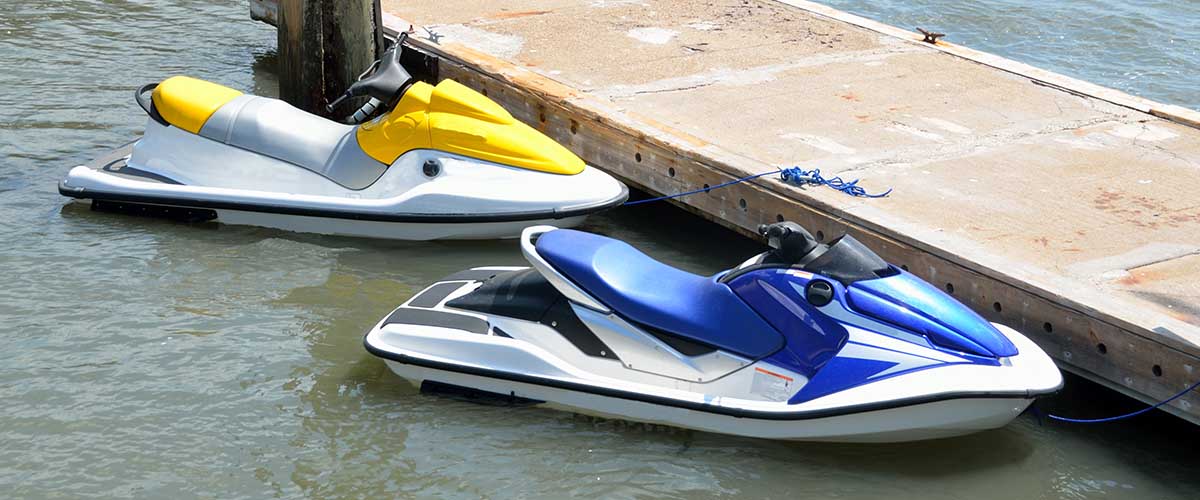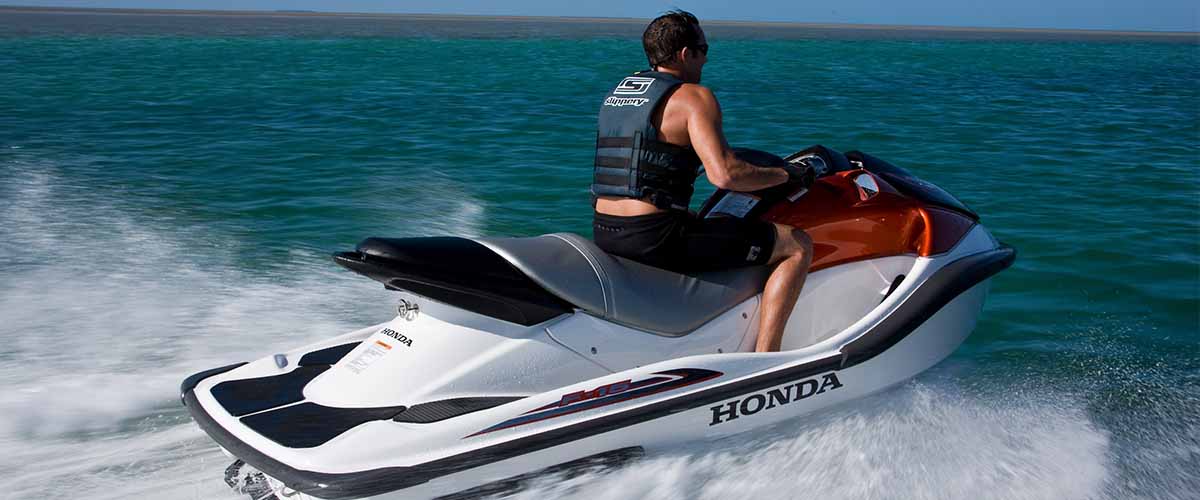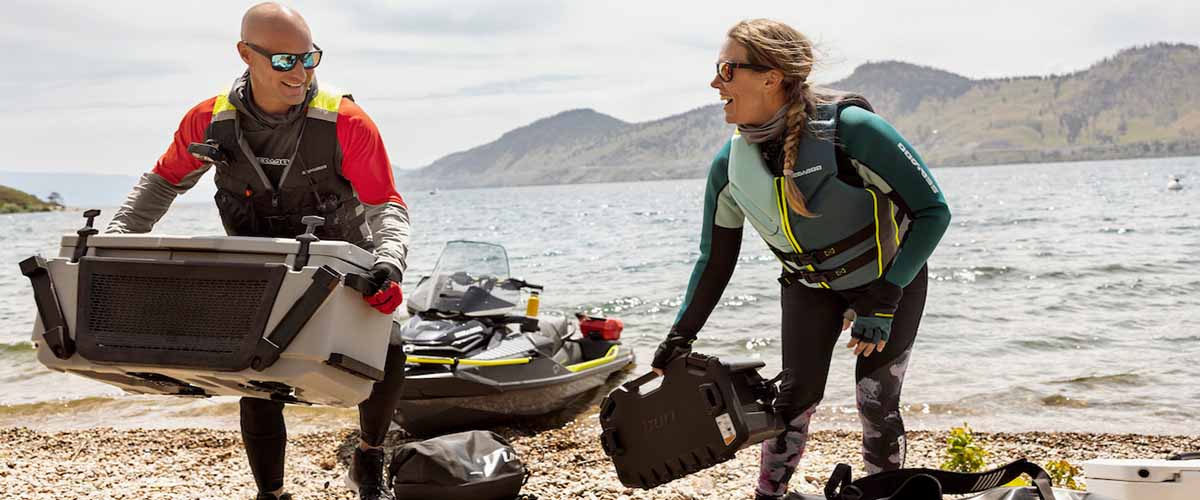How to Dock a Jet Ski Like A Pro [A Step-by-Step Guide]
Docking a jet ski can be very stressful, especially for beginner riders.
If you’ve just purchased your new jet ski, you probably want to know how to properly tie it to a dock.
For your convenience, we at JetDrift have gathered all you need to know into this step-by-step jet ski docking guide!
Can You Dock a Jet Ski?
Yes, you can dock a jet ski, but beware of the many hull damages that can occur when jet skis are docked. Because of this concern, many owners prefer anchoring or even beaching their jet skis, rather than tying them to a dock. Also, if you want to dock your jet ski for the season, it’s highly recommended that you invest in a jet ski lift or a drive on dock.
This is because jet skis can’t be stored in the water for the long run due to their design.
Since you usually have to dock your jet ski after launching or before loading onto the trailer, you may want to know how to do it properly.
How to Dock a Jet Ski
To dock a jet ski properly, you first have to get familiar with the dock and its surroundings. Know the local rules, keep your eyes on other vessels and buoys while monitoring the weather. Prepare the accessories, plan ahead and try to choose an empty and protected spot. Approach the dock slowly, with just idle speed. After your jet ski comes alongside the dock, turn off the engine and tie the jet ski to the dock.
Is it this easy to dock a jet ski?
The answer is yes and no, as there are some key points you have to pay extra attention to during the procedure.
It’s also wise to get some practice before you try to dock your jet ski in a crowded marina on a busy Sunday!
Step-by-Step Jet Ski Docking Guide
Practice First
If you want to dock your jet ski like a pro you will have to practice first to get familiar with how your jet ski operates.
Keep in mind that each jet ski has a different hull size, weight, and features. Thus, they have different characteristics.
First, it’s recommended that you practice on the open water with a buoy before you try to actually dock the jet ski.
Keep in mind that jet skis are powered with a jet pump, which means you need throttle to steer!
Fortunately, more and more jet skis are manufactured with brake systems like iBR or RiDE.
These not only help your jet ski to stop in a shorter distance, they also do a very good job when maneuvering the jet ski around the dock. If your jet ski doesn’t feature these systems, beware that docking will be more difficult.
Once you can operate your jet ski with confidence you can move to an empty dock. It’s best if you try to get some practice in on weekdays when the docks are much quieter.
You should practice arriving and departing over and over again. When practicing, approach the dock many times from different angles.
The key is to always operate your jet ski at idle speed, so you can avoid bumping into the dock!
If you feel you are in need of help, you can always ask for advice and guidance from experienced riders.
Be Prepared with a Plan
Before you even head to the dock, make sure that the mooring accessories like dock lines, ropes, and bumpers are easily available.
It’s also imperative to plan ahead especially if you plan on tying your jet ski to an unfamiliar dock.
You have to pay attention to the water depth, as jet skis can’t be operated in water that is less than 3 feet deep. Additionally, you have to avoid running over seaweed and debris as these can be sucked up into the pump.
You may also want to keep your eyes on the environment as wind, waves, wakes, and currents can make docking harder. Depending on their direction, these forces can drift you away from the dock, or worse yet, they can push your jet ski towards it!
Because of these concerns, you should always consider these factors so that you can dock your jet ski safely.
Know the Laws and Regulations
To stay safe and legal you have to follow the local rules and regulations.
As a rule of thumb, you can find “no wake” zones around docks and marinas, which means you have to reduce your speed to idle when you arrive at a certain distance from the marina or dock.
Beyond no-wake zones never overlook the markers like buoys, which usually delineate the channel to the dock or warn you to stay away from rocks or other submerged objects.
Pay Attention to Others
Besides the markers, you have to pay double attention to other objects and vessels around you. You can expect a lot of traffic in crowded marinas, especially on weekends.
Be careful, as everyone makes mistakes and sometimes jet skis don’t offer as much protection as boats.
Learn the regulations and the boating etiquette to stay safe and legal in marinas. Don’t forget that even if your jet ski is quite small, it’s still considered a boat by law.
This means that jet skis have the same responsibilities and rights as any other boat in the marina.
You also have to keep your eyes on debris and especially ropes and dock lines that can often be found in the water. These can cause a jam in the pump if your jet ski sucks them up!
Finding your Spot
Finding the perfect spot for your jet ski can be tricky, especially if you are in a new marina. When selecting your spot here are the most important factors to consider:
– The No. 1 rule is to always try to dock as far from other vessels as possible. This is the best way to avoid hitting other vessels and to make your docking procedure much easier and less stressful.
– If you have to dock into a tight place between vessels, make sure upfront that there is enough space for your jet ski.
– Keep in mind that you can only use transient docks (often called day docks or guest docks) in many marinas, as these are the designated spots for guests.
– You can tie your jet ski to fuel docks only if you want to refuel. Use these fuel docks only for as long as is absolutely necessary.
– Check the height and design of the dock. Unfortunately, docks are designed for larger boats so sometimes you have to “climb up” to the dock from your jet ski. But the worst scenario is when the dock is so high that the jet ski accidentally slips underneath it. To avoid this, always try to choose a lower dock if it’s possible.
– Keep security in mind and try to avoid unattended spots, the ones that are too far and not visible from the shore.
– Always try to avoid unprotected sides of the docks, which are exposed to the elements and the wakes created by boat traffic. In general, the land side of a dock is the better choice.
Finally, selecting your spot always requires compromise, but the best practice is to choose the most secure and protected location to park your jet ski. Safety first!
Take it Slow
When it comes to docking a jet ski the rule of thumb is: “Never approach the dock any faster than you’re willing to hit it.”
This means the key is to always operate your jet ski at idle speed during the whole procedure. Sadly, many beginners bump into the dock because they approach too fast!
Beware that many jet ski models don’t have brakes and a reverse system! Moreover, most jet skis have no neutral, which can also be confusing for beginners.
Because of this, you need to know how to operate your jet ski securely before your first docking.
To keep it slow, the best practice is to release the throttle a sufficient distance from the dock and ride to it at idle speed.
Docking Your Jet Ski
To properly dock a jet ski, approach the dock at a slight angle if possible. Use a combination of shifting forward and reverse until the hull comes alongside the dock.
If your jet ski features a brake and reverse system, you can dock more easily alternating the throttle with the brake lever. But keep in mind that when backing up the jet ski, the steering direction is reversed!
You should operate the craft with very few throttle bursts instead of at a steady speed. In this way, the jet ski doesn’t build up too much momentum.
If your jet ski isn’t equipped with a manual reverse or brake, you have to turn off the engine at a safe distance before you reach the dock, and let the water drag stop your jet ski.
Are you wondering what this safe distance is?
Unfortunately, it varies from model to model, as it depends on many factors like the jet ski’s curb weight, the dimensions of the hull and many others.
Moreover, it may differ from one ride to another as the waves, current actions or even wind can also affect your jet ski’s behavior, moving it away or toward the dock.
Also, don’t forget that if you ride with passengers or a lot of gear, you can expect for longer stopping distance due to the extra weight, and the jet ski will also be more unstable at slower speeds.
As you can see, the stopping distance depends on many factors, which makes it tricky to dock a jet ski that doesn’t feature brake and reverse systems.
Once you’ve grabbed the dock, turn off the engine (if you have not already done so) and tie the jet ski to the dock.
And finally, don’t be afraid to fail, as everyone was once a beginner. If docking isn’t going well, you can try again or even look for another spot.
How to Tie a Jet Ski to a Dock
The best way to tie a jet ski to a dock is by using docking lines or ropes. Best practice is to attach two docking lines to the eyes on the jet ski’s front and rear side, while securing the other ends of the lines to the dock. Finally, put the bumpers in place to protect the jet ski from damage.
Let’s take a closer look at these jet ski mooring accessories!
Jet Ski Docking Lines and Ropes
The jet ski docking lines, also known as jet ski dock lines, come in different colors, lengths, and designs. The best jet ski docking lines are arguably the “bungee lines,” as they are easy to install and flexible.
Drawbacks?
Unfortunately, sometimes they prove to be too short. This is because docks can have poles, rings, or cleats that you can tie your jet ski to, and sometimes these are not close enough to your spot.
But don’t worry, because in this case you can also use regular ropes to tie your jet ski. Because of this, along with a pair of docking lines in your jet ski, it’s also wise to store a longer rope beside them.
It may come in handy if your jet ski needs a tow, or if you want to anchor it in deeper water.
The best practice is to tie your jet ski to cleats rather than rings or poles, as it’s much easier to tie off from a cleat, which makes departing faster.
You can also try to use more docking lines to hold your jet ski off the dock as far as possible to avoid damage.
Jet Ski Bumpers
Although many docks feature bumpers, these are usually mounted too high to protect your jet ski.
To avoid scratches and serious hull damage, it’s recommended that you invest in some special jet ski bumpers (known as jet ski fenders).
You have to place these bumpers between the hull and the dock, but there are also special models that can be mounted on the edge of the footwells.
These jet ski fenders provide a cushion when the hull bumps into the dock due to wind or waves.
Locks
If you leave your jet ski unattended it makes sense to secure it to the dock with a cable lock.
The Drawbacks and Risks of Docking a Jet Ski
Despite its popularity, there are many drawbacks and risks of docking a jet ski:
Time limits: Some guest docks can be used only for a limited time, generally for a couple of hours. If you want to use it for a longer period of time you may be charged.
Docking fees: In many cases you have to pay docking fees even if you use the dock for a short time.
Damages: As you already know there is a high risk that your jet ski can get damaged from the dock or other vessels. According to PersonalWatercraft, the most common types of damage are scratches, broken mirrors and tears on the seat.
Stress: Docking a jet ski always causes some stress, especially in a crowded marina.
Sinking: If you leave your jet ski sitting in the water, you risk water leaking into the hull, which can end with the sinking of your jet ski.
Security issues: If you leave your jet ski unattended it could even be stolen or damaged.
Because of these concerns, many owners prefer anchoring or beaching their jet ski rather that docking it.
Conclusion
Docking a jet ski can be stressful, especially for beginners. But let’s face it, it’s often unavoidable, as you have to tie your jet ski to a dock several times after you launch or refill it at a fuel dock.
Moreover, jet skis usually have to be docked on longer tours in most cases.
But don’t worry, you can dock your jet ski like a pro by following these simple steps:
– Get plenty of practice first
– Know the local rules and regulations
– Be prepared and plan ahead
– Watch out for markers and buoys
– Pay attention to other vessels
– Always operate slowly
– Alternate the throttle and the brake levers carefully
– Use bungee jet ski dock lines to tie off the dock
– Always use fenders to protect your jet ski from damage
– Always remove the key when you get off your jet ski
– Never leave your jet ski unattended if at all possible
Unfortunately, docks are not designed for jet skis. They are usually too high and jet skis can slip under them easily.
Beyond this, there are some drawbacks and risks of docking a jet ski, which are respectively:
– Docking fees
– Time limitations at guest docks
– Damage from the dock or other vessels
– Stress
– Risk of sinking
– Security issues
If you don’t want to dock your jet ski, you can consider beaching or even anchoring it in many situations.
———–
References:
https://www.personalwatercraft.com/features/five-common-pwc-ownership-mistakes-1303.html
https://intrepidcottager.com/sea-doo-docking/
DISCOVER 2024 PWC MODELS Kawasaki, Sea-Doo, Yamaha, Krash…





